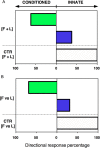Learning by Association in Plants
- PMID: 27910933
- PMCID: PMC5133544
- DOI: 10.1038/srep38427
Learning by Association in Plants
Abstract
In complex and ever-changing environments, resources such as food are often scarce and unevenly distributed in space and time. Therefore, utilizing external cues to locate and remember high-quality sources allows more efficient foraging, thus increasing chances for survival. Associations between environmental cues and food are readily formed because of the tangible benefits they confer. While examples of the key role they play in shaping foraging behaviours are widespread in the animal world, the possibility that plants are also able to acquire learned associations to guide their foraging behaviour has never been demonstrated. Here we show that this type of learning occurs in the garden pea, Pisum sativum. By using a Y-maze task, we show that the position of a neutral cue, predicting the location of a light source, affected the direction of plant growth. This learned behaviour prevailed over innate phototropism. Notably, learning was successful only when it occurred during the subjective day, suggesting that behavioural performance is regulated by metabolic demands. Our results show that associative learning is an essential component of plant behaviour. We conclude that associative learning represents a universal adaptive mechanism shared by both animals and plants.
Figures



Comment in
-
Lack of evidence for associative learning in pea plants.Elife. 2020 Jun 23;9:e57614. doi: 10.7554/eLife.57614. Elife. 2020. PMID: 32573434 Free PMC article.
References
-
- Merkle J. A., Fortin D. & Morales J. M. A memory-based foraging tactic reveals an adaptive mechanism for restricted space use. Ecol. Lett. 17, 924–931 (2014). - PubMed
-
- Whitfield M., Köhler A. & Nicholson S. W. Sunbirds increase foraging success by using color as a cue for nectar quality. Behav. Ecol. 25, 328–334 (2014).
-
- Aristotle, Nicomachean Ethics: Translation, introduction, and commentary (Trans. and Intro Broadie S. & Rowe C.) (Oxford University Press, 2002).
Publication types
MeSH terms
LinkOut - more resources
Full Text Sources
Other Literature Sources

